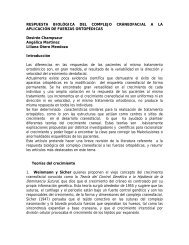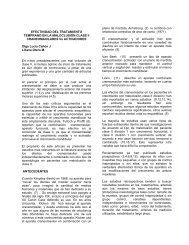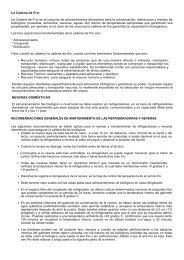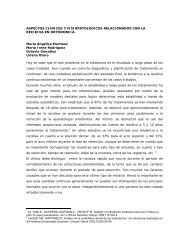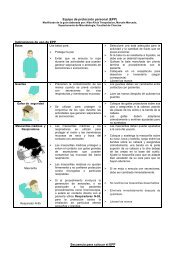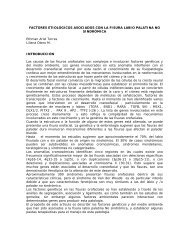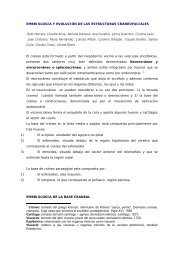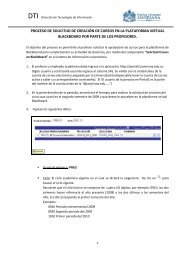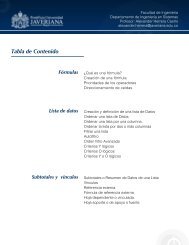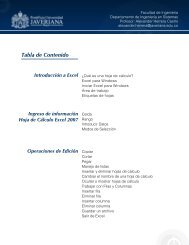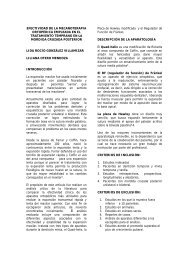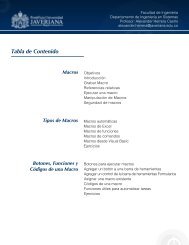META-ANALSIS EFECTIVIDAD DEL TRATAMIENTO EN LA ...
META-ANALSIS EFECTIVIDAD DEL TRATAMIENTO EN LA ...
META-ANALSIS EFECTIVIDAD DEL TRATAMIENTO EN LA ...
You also want an ePaper? Increase the reach of your titles
YUMPU automatically turns print PDFs into web optimized ePapers that Google loves.
<strong>EFECTIVIDAD</strong> DE <strong>LA</strong> APARATOLOGÍA ORTOPÉDICA UTILIZADA PARA EL<br />
<strong>TRATAMI<strong>EN</strong>TO</strong> TEMPRANO DE <strong>LA</strong> MALOCLUSION C<strong>LA</strong>SE III<br />
Angela Ortiz.<br />
Iván Darío Ortiz.<br />
Liliana Otero M.<br />
INTRODUCCIÓN<br />
El tratamiento de la maloclusión clase III en edades tempranas, es controvertido<br />
debido a la dificultad que representa predecir el potencial de crecimiento del<br />
paciente, y al origen genético de esta maloclusión. Típicamente el tratamiento en<br />
pacientes jóvenes con clase III se ha dirigido a la modificación del crecimiento por<br />
medio de fuerzas ortopédicas que intentan estimular el crecimiento del maxilar<br />
superior, inhibir el crecimiento del maxilar inferior, o ambas. (1)<br />
Aproximadamente el 5% de la población caucásica exhibe una maloclusión clase<br />
III. La prevalencia reportada para las poblaciones Japonesa y Escandinava parece<br />
ser significativamente más alto. La mayoría de estos pacientes reciben tratamiento<br />
hasta que el crecimiento activo se ha completado. En Europa y en Japón las fuerzas<br />
extraorales son comúnmente usadas como un intento de corregir esta<br />
maloclusión.(2), pero frecuentemente el segundo pico de crecimiento del paciente<br />
provoca la recidiva del tratamiento temprano, por esta razón la alternativa<br />
terapéutica tardía suele ser la cirugía ortognática o una compensación de camuflaje<br />
por medio de ortodoncia.<br />
ETIOLOGÍA DE <strong>LA</strong> C<strong>LA</strong>SE III ESQUELÉTICA<br />
Aún no es posible determinar cuáles son los factores etiológicos: genéticos y<br />
ambientales involucrados en el desarrollo de una maloclusión. Sin embargo, una de<br />
las maloclusiones que al parecer presenta mayores rasgos genéticos, debido a las<br />
características fenotípicas de la base de cráneo y de los maxilares superior e<br />
inferior, de los pacientes y del núcleo familiar afectado, es la clase III esquelética.<br />
Otro de los rasgos fenotípicos característicos y heredables de esta maloclusión son<br />
las compensaciones dentales.<br />
CARACTERÍSTICAS MORFOLÓGICAS DE LOS PACI<strong>EN</strong>TES CON C<strong>LA</strong>SE III Y<br />
PSEUDO C<strong>LA</strong>SE III (Diagnóstico diferencial)<br />
Pseudoclase III:<br />
Mandíbula presenta tamaño normal.<br />
Incisivos superiores retroinclinados, incisivos inferiores pro inclinados o en<br />
posición normal<br />
En relación céntrica el perfil se observa recto y en posición habitual<br />
ligeramente cóncavo<br />
Relación molar clase I o clase III<br />
Longitud mandibular normal<br />
tercio medio disminuído<br />
Clase III verdadera:<br />
Retrognatismo o micrognatismo del maxilar superior<br />
Prognatismo o Macrognatismo mandibular<br />
Combinación de alteraciones en tamaño y posición del maxilar superior e<br />
inferior<br />
Base de cráneo anterior corta
Incisivos superiores proinclinados y los incisivos mandibulares<br />
retroinclinados (compensación dentoalveolar)<br />
Presenta algún grado de herencia familiar<br />
Características faciales: El surco mento-labial aplanado es propio de la<br />
clase III, al igual que el perfil cóncavo. El tercio medio deprimido hace<br />
referencia al poco desarrollo de los huesos malar y maxilar.<br />
HERRAMI<strong>EN</strong>TAS DIAGNÓSTICAS PARA DETERMINAR EL PICO DE<br />
CRECIMI<strong>EN</strong>TO <strong>EN</strong> <strong>LA</strong>S MUJERES:<br />
En odontología y específicamente en ortodoncia y cirugía, se han presentado<br />
diferentes métodos para calcular el pico de crecimiento en los sujetos. El registro<br />
del MP3 (densidad ósea del sesamoideo abductor del dedo), los indicadores<br />
tomados del desarrollo esquelético de la mano y la muñeca (la osificación de la<br />
falange distal del primer dedo, normalmente ocurre después del máximo<br />
crecimiento puberal, cuando se espera un mínimo de crecimiento en la altura<br />
corporal), la radiografía de las vértebras cervicales, el desarrollo puberal como la<br />
menarquia (el segundo pico de crecimiento se observa generalmente uno a dos<br />
años antes de este evento) en las mujeres y el cambio de voz en los hombres, el<br />
estado de mineralización dental y la concentración de la Hormona somatotropina<br />
en sangre, son algunos de los métodos usados para evaluar el crecimiento<br />
esquelético de los pacientes.<br />
INDICACIONES DE <strong>LA</strong> PROTRACCIÓN MAXI<strong>LA</strong>R:<br />
-Retrognatismo del maxilar superior.<br />
-Deficiencia en el crecimiento sagital del maxilar superior.<br />
-Deficiencia del tercio medio facial.<br />
-Prognatismo mandibular moderado.<br />
-Clase III con mordida profunda y tercio inferior disminuido.<br />
-Pacientes en etapa de crecimiento<br />
Limitaciones de la protracción maxilar:<br />
En pacientes de cara larga, o con tendencia a mordida abierta esquelética porque<br />
uno de los efectos de la máscara facial de protracción es la rotación de la<br />
mandíbula hacia abajo y hacia atrás.<br />
MANEJO <strong>DEL</strong> APIÑAMI<strong>EN</strong>TO SEVERO <strong>EN</strong> MALOCLUSIONES CON PSEUDO<br />
C<strong>LA</strong>SE III Y C<strong>LA</strong>SE III:<br />
Uno de los recursos más empleados para el tratamiento temprano del apiñamiento<br />
severo, pero a la vez de mayor controversia, es la extracción seriada, pero no es<br />
objeto de este artículo discutir a fondo las opciones terapéuticas posibles del caso.<br />
Otra alternativa son las extracciones terapéuticas, generalmente de primeros<br />
premolares. Recientemente la aparatología ortopédica empleada para expansión y<br />
distalización, se mencionan en la literatura como recursos válidos para el<br />
tratamiento de esta maloclusión.<br />
Indicaciones de la expansión:<br />
En apnea obstructiva del sueño, en maloclusiones originadas por factores<br />
etiológicos derivados de problemas en las vías aéreas superiores, en patrones<br />
esqueléticos clase III con micrognatismo transversal del maxilar superior, en<br />
mordidas cruzadas posteriores, en pacientes con labio y paladar fisurados, en<br />
pacientes con apiñamiento severo y moderado del maxilar superior (Todas estas<br />
alternativas se consideran en pacientes en crecimiento). Los pacientes adultos, las<br />
maloclusiones con tendencia a mordida abierta esquelética y los pacientes que<br />
presentan patrones de crecimiento vertical, se consideran como limitantes en este<br />
tipo de mecanoterapia.
Para el tratamiento temprano del apiñamiento severo en la maloclusión clase III,<br />
frecuentemente se emplea la disyunción. En pacientes con dentición permanente y<br />
clase III verdadera, una de las estrategias más utilizadas es el tratamiento<br />
combinado: ortodoncia y cirugía ortognática.<br />
EDAD IDEAL PARA REALIZAR <strong>LA</strong> CIRUGÍA <strong>EN</strong> C<strong>LA</strong>SE III ESQUELÉTICA:<br />
Actualmente, la tendencia es operar tan pronto cese el crecimiento máximo<br />
individual esperado. Con la ayuda de las herramientas diagnósticas, ya<br />
mencionadas, utilizadas para evaluar el crecimiento esquelético, se determina el<br />
momento más favorable para operar. Sin embargo existen múltiples variables que<br />
deben ser consideradas en esta decisión. La etiología de la clase III (patologías,<br />
síndromes, hiperplasia condilar activa), el tipo de cirugía que se va a realizar y la<br />
aparatología diseñada para mantener la estabilidad postquirúrgica, son entre otros,<br />
algunos de los aspectos que deben ser revisados.<br />
P<strong>LA</strong>N DE <strong>TRATAMI<strong>EN</strong>TO</strong><br />
La literatura indica que cualquier fuerza trasmitida hacia la mitad de la cara desde<br />
una M<strong>EN</strong>TONERA resultará en modificación del crecimiento mandibular (3)<br />
La mentonera ha sido usada para interceptar el crecimiento incipiente de<br />
maloclusiones clase III, retardando o restringiendo el crecimiento de la mandíbula<br />
para obtener una mejor relación antero-posterior de los maxilares.<br />
La reducción significativa de la capa precondoblástica del cartílago condilar en<br />
experimentos con ratas sugieren una respuesta del cóndilo al estímulo mecánico,<br />
que se traduce como retardo en el crecimiento vertical de la longitud de la rama, al<br />
usar este tipo de aparatología. Otros estudios han reportado estos cambios por<br />
medio de trazos cefalométricos en pacientes japoneses y en caucásicos(4).<br />
A mediados del siglo XX la Mentonera fue considerada como un éxito en el<br />
tratamiento de las maloclusiones clase III, porque provocaba un desplazamiento<br />
distal de la mandíbula y una ligera inclinación lingual de los incisivos inferiores y se<br />
reportó, mediante radiografías de casos de pacientes clase III tratados con esta<br />
aparatología, un retardo en el crecimiento hacia delante del mentón con<br />
disminución del ángulo goníaco (5), (6).<br />
Numerosos estudios reportados en la literatura Japonesa, soportan el efecto<br />
ortopédico de la mentonera sobre el crecimiento mandibular. Estos estudios<br />
sugieren que las fuerzas extraorales soportadas sobre el mentón, mejoran el ángulo<br />
mandibular, la relación sagital entre los maxilares y reducen el crecimiento<br />
mandibular (7)<br />
Sin embargo, al parecer la mentonera no es efectiva en pacientes clase III quienes<br />
presentan retrognatismo o micrognatismo del maxilar superior. Nanda, y col (2),<br />
reportaron que la maxila de los simios puede ser desplazada anteriormente usando<br />
fuerzas extraorales. Este protracción maxilar afecta las suturas y origina cambios<br />
histológicos (8). Hass realizó movimientos descendentes y anteriores del maxilar,<br />
como resultado de la expansión palatina combinada con la tracción anterior por<br />
medio de elásticos.<br />
Delaire, Verdon y Floor han impulsado fuertemente el uso de la máscara de<br />
protracción anterior, para el tratamiento temprano de maloclusiones clase III<br />
debidas a retrognatismo o micrognatismo del maxilar superior.<br />
La popularidad de la máscara ha aumentado debido al aparente aumento en la<br />
incidencia de la maloclusión clase III. Además numerosos reportes clínicos<br />
sugieren que su alcance ortopédico es más exitoso que otras técnicas como
mentoneras, aparatos funcionales o terapia de camuflaje. Uno de las causas<br />
propuestas para explicar el incremento en la incidencia de clase III en los Estados<br />
Unidos se refiere al aumento en la inmigración de personas con alto grado de<br />
maloclusión clase III (9).<br />
Por otra parte, la actividad muscular presente en individuos con clase III es<br />
diferente a la observada en pacientes con normoclusión. El regulador de Frankel<br />
cumple su efecto usando las fuerzas de los músculos. Este aparato, permite que la<br />
presión de la lengua actúe sobre los dientes deteniendo la presión de las mejillas, lo<br />
cual produce expansión del maxilar y condiciona a la mandíbula a adquirir una<br />
nueva posición.<br />
El propósito de este artículo fue realizar un análisis crítico de la literatura para<br />
evaluar los resultados obtenidos en los estudios realizados en pacientes con<br />
maloclusiones Clase III, donde se usaron Mentoneras, Máscara Facial y/o Frankel<br />
III.<br />
OBJETIVOS ESPECÍFICOS<br />
*Analizar si los cambios obtenidos se deben al crecimiento esquelético del<br />
maxilar superior o inferior, a cambios posturales de los maxilares, o a efectos<br />
dento-alveolares.<br />
*Observar si existen respuestas diferentes dependiendo del patrón de<br />
crecimiento del paciente.<br />
*Determinar el tiempo ideal para iniciar el tratamiento.<br />
Para tal fin se realizó una búsqueda inicial de 120 artículos relacionados con el<br />
tratamiento de maloclusiones clase III, de los cuales se escogieron finalmente 25,<br />
teniendo en cuenta variables como edad del paciente, tipo de aparatología, modo<br />
de acción, raza, tipo de dentición, presencia de grupos control y tiempo de uso del<br />
aparato.<br />
RESULTADOS:<br />
Se tomaron en cuenta únicamente estudios que incluyeran grupo control.<br />
Con instrumentos de medición que permitieran evaluar la continuidad del<br />
tratamiento. La edad del estudio se concentró dentro de los parámetros de una<br />
dentición mixta temprana.<br />
Considerando los hallazgos encontrados a través del estudio de estos reportes, se<br />
puede observar:<br />
El tratamiento con máscara facial para la protracción maxilar, produjo un<br />
movimiento hacia abajo y adelante del maxilar con un leve movimiento superior<br />
anterior del plano palatino. Como consecuencia se produce una rotación mandibular<br />
hacia abajo y hacia atrás, que mejora la relación intermaxilar sagital. El tiempo<br />
ideal para iniciar esta terapia parece ser, durante el primer pico de crecimiento en<br />
niñas y niños, que coincide con la etapa de dentición mixta temprana.<br />
La mentonera produjo una rotación hacia abajo y atrás de la mandíbula, pero al<br />
parecer, no tiene ningún efecto sobre el maxilar superior. La edad sugerida para<br />
iniciar el tratamiento corresponde a la época de dentición mixta temprana.<br />
Los cambios obtenidos por el regulador de Frankel son debidos a cambios<br />
dentoalveolares, pero se recomienda usarlo durante más de 10 horas diarias, lo<br />
que implica una gran colaboración por parte del paciente.
CONCLUSIONES<br />
*Al parecer la máscara facial, es el único aparato ortopédico, que pude modificar el<br />
crecimiento de l os maxilares, en pacientes que presenten clase III esquelética.<br />
*Los cambios esqueléticos producto de la Máscara parecen estar mejor<br />
sustentados. A diferencia de la mentonera donde los estudios son más polémicos<br />
debido a los instrumentos de medición utilizados.<br />
*Los tratamientos realizados con mentonera reportan un alto grado de recidiva.<br />
*El aparato de Frankel III, parece ser más efectivo en el período de retención,<br />
(para mantener la estabilidad de los resultados conseguidos con la máscara facial),<br />
que en la fase activa del tratamiento temprano.<br />
*La Máscara Facial está indicada en pacientes con deficiencia de crecimiento del<br />
Maxilar Superior.<br />
*Las mentoneras y Frankel III se han visto que presentan mejor resultado cuando<br />
se usan como aparatos de contención en pacientes quirúrgicos o en pacientes<br />
tratados con Máscara Facial<br />
BIBLIOGRAFIA<br />
1.COZZANI. GIUSEPPE. SPEZIA IA. Extraoral traction and Class III treatment. Am J<br />
Orthod Dent . 1981: 638-650.<br />
2. NANDA, RAVINDRA. CONN, FARMINGTON. Biomechanical and clinical<br />
considerations of a modified protraction headgear. Am J Orthod Dent. 1980.. 125-<br />
139.<br />
3. RITUCCI, RICHARD. NANDA, RAVINDRA. The effect of chincup therapy on the<br />
growth and development of the cranial base and midface. Am J Orthod Dent. 1986.<br />
475-483.<br />
4. MITANI, HIDEO. FUKAZAWA, HIROFUMI. Effects of chincup force and the timing<br />
and amount of mandibular growth associated with anterior reverse occlusion (class<br />
III maloclusión) during puberty. Am J Orthod Dent .1986 .454-463.<br />
5. SAKAMOTO. TOSHIHIKO. IWASE. Et al. A roentgenocephalometric study os<br />
skeletal changes during and after chincup treatment. Am J Orthod Dent 1984 :341-<br />
350.<br />
6. SUGAWARA, JUNJI. ASANO, TERUO. <strong>EN</strong>DO, NORIAKI. MITANI, HIDEO. Longterm<br />
effects of chincup therapy on skeletal profile in mandibular prognathism. Am J<br />
Orthod Dent .1990 :127-133.<br />
7. BAIK,HYOUNG. Clinical results of the maxillary portraction in Koream children.<br />
Am J Orthod Dent. 1995 :583-592.<br />
8. W<strong>EN</strong><strong>DEL</strong>L, P. NANDA, R. The effects of chincup therapy on the mandible: A<br />
longitudinal study. Am J Orthod Dent. 1985. 265-274.
9. NARTALLO-TURLEY P. TURLEY, P. Cephalometric effects of combined palatal<br />
expansion and facemask therapy on Class III malocclusion. Angle 1998. Nº 3 :217-<br />
224.<br />
10.. BACEETTI, T. McGILL, J. FRANCHI, L. McNAMARA, J. TAL<strong>LA</strong>RO, I. Skeletal<br />
effects of early treatment of lass III malocclusion with maxillary expansion and<br />
face-mask therapy. Am J Orthod Dent .1998. 113 (3). 217-224<br />
11. DEGUCHI, T. IWAHARA, K. Electromyographic investigation of chin cup therapy<br />
in Class III malocclusion. Angle 1998. 5 ;419-424.<br />
12. WALES, C. An examination of treatment changes in children treated with the<br />
function regulator of Frankel. Am J Orthod Dent 1983 :299-310.<br />
13. ULG<strong>EN</strong>, M. FIRATLI, S. The effects of the Frankel´s function regulator on the<br />
Class III malocclusion. Am J Orthod Dent 1994 .561-567.<br />
14. CHONG, Y. IVE, J. ARTUN,J. Changes following the use of protraction headgear<br />
for early correction of Class III malocclusion. Angle 1996. 5;3510-3629.<br />
15. GAL<strong>LA</strong>GHER. R.W. MIRANDA, F. BUSCHANG, P. Maxillary protraction:<br />
Treatment and posttreatment effects. Am J Orthod Dent .1998 113. (6);213-6.<br />
16. KILICOGLU, H. KIRLIC, Y. Profile changes in patients with Class III<br />
malocclusions after Delaire mask therapy. Am J Orthod Dent 1998. 113 ( 4).127-5<br />
17. DEGUCHI, T. KURADA, T. MINOSHIMA, Y. GRABER,T. Craniofacial features of<br />
patients withj Class III abnormalities: Growth-related changes and effecta of shortterm<br />
and long-term chincup therapy. Am J Orthod Dent. 2002. 121(1).132-9<br />
18. SAADIA, M. TORRES, E. Saggital changes after maxillary protraction with<br />
expansion in Class III patients in the primary, mixed, and late mixed dentitions: A<br />
longitudinal retrospective study. 2000 117(6).345-7<br />
19. MITANI, H. Early application of chincup therapy to skeletal Class III<br />
maloclusión. . Am J Orthod Dent. Juni 2002 . 121 ( 6).298-2.<br />
20. PERDOMO A. WASSERMAN, I. Efectividad de la màscara facial en la protracción<br />
maxilar. Universitas Odontológicas. 1998. Nº 38 ;33-44.<br />
21. KAPUST, A. SINC<strong>LA</strong>IR, P. TURLEY, P. Cephalometric effects of face<br />
mask/expansion therapy in Class III children: A comparison of three age groups.<br />
Am J Orthod Dent. 1998 113. (2)98-104.<br />
22.KAJIYAMA, K. MURAKAMI, T. SUZUKI, A. Evaluation of the modified maxillary<br />
portractor applies to Class III maloclusión with retruded maxilla in early mixed<br />
dentition. Am J Orthod Dent. 2000 .118 (5):231-5<br />
23. MERMIGOS , J. FULL, C. ANDREAS<strong>EN</strong>, G. Protraction of the maxillofacial<br />
complex. . Am J Orthod Dent .1990 .47-55.<br />
24. ISHII, H. MORITA, SI. TAKEUCHI, Y. NAKAMURA, S. Treatment effect of<br />
combined maxillary protraction and chincap appliance in severe skeletal Class III<br />
cases. Am J Orthod Dent. 1987 .304-312.
25.SAKAMOTO, T. Efecctive Timing the application of orthopedic force in the<br />
skeletal Class III malocclusion. Am J Orthod Dent. 1981 .411-416.<br />
LECTURAS RECOM<strong>EN</strong>DADAS<br />
1. IMAMURA N, ONO T, HIYAMA S, ISHIWATA Y, KURODA T. Comparison of<br />
the sizes of adenoidal tissues and upper airways of subjects with and<br />
without cleft lip and palate. Am J Orthod Dentofacial Orthop. 2002<br />
Aug;122(2):189-94; discussion 194-5.<br />
2. LINDER-ARONSON S. Adenoids. Their effect on mode of breathing and nasal<br />
airflow and their relationship to characteristics of the facial skeleton and the<br />
denition. A biometric, rhino-manometric and cephalometro-radiographic<br />
study on children with and without adenoids. Acta Otolaryngol Suppl.<br />
1970;265:1-132.<br />
3. WOODSIDE DG, LINDER-ARONSON S, LUNDSTROM A, MCWILLIAM J.<br />
Mandibular and maxillary growth after changed mode of breathing. Am J<br />
Orthod Dentofacial Orthop. 1991 Jul;100(1):1-18.<br />
4. BEHLFELT K. Enlarged tonsils and the effect of tonsillectomy. Characteristics<br />
of the dentition and facial skeleton. Posture of the head, hyoid bone and<br />
tongue. Mode of breathing. Swed Dent J Suppl. 1990;72:1-35.<br />
5. KLUEMPER GT, SPALDING PM. Realities of cra-niofacial growth modification.<br />
Atlas Oral Maxillofac Surg Clin North Am. 2001 Mar;9(1):23-51. Review.<br />
6. ZHOU Y, HAGG U, RABIE AB. Severity of dentofacial deformity, the<br />
motivations and the outcome of surgery in skeletal Class III patients. Chin<br />
Med J (Engl). 2002 Jul;115(7):1031-4.<br />
7. KAHL-NIEKE B, FISCHBACH H, SCHWARZE CW. Post-retention crowding and<br />
incisor irregularity: a long-term follow-up evaluation of stability and relapse.<br />
Br J Orthod. 1995 Aug;22(3):249-57.<br />
8. LITTLE RM. Stability and relapse of dental arch alignment. Br J<br />
Orthod. 1990 Aug;17(3):235-41<br />
9. GILMORE CA, LITTLE RM. Mandibular incisor dimensions and crowding. Am<br />
J Orthod. 1984 Dec;86(6):493-502.<br />
10. CHAUSHU S, SHARABI S, BECKER A. Dental morphologic characteristics of<br />
normal versus delayed developing dentitions with palatally displaced<br />
canines. Am J Orthod Dentofacial Orthop. 2002 Apr;121(4):339-46.<br />
11. TURPIN DL. Early treatment conference alters clinical focus. Am J Orthod<br />
Dentofacial Orthop. 2002 Apr;121(4):335-6<br />
12. PALLECK S, FOLEY TF, HALL-SCOTT J. The reliability of 3 sagittal reference<br />
planes in the assessment of Class I and Class III treatment. Am J Orthod<br />
Dentofacial Orthop. 2001 Apr;119(4):426-35.
13. NAGAHARA K, YUASA S, YAMADA A, ITO K, WATANABE O, IIZUKA T, SAKAI<br />
M, UTIDA H. Etiological study of relationship between impacted permanent<br />
teeth and malocclusion Aichi Gakuin Daigaku Shigakkai Shi. 1989<br />
Dec;27(4):913-24<br />
14. HAAVIKKO K. The effect of crowding to the formation of permanent tooth.<br />
Proc Finn Dent Soc. 1973;69(1):7-12.<br />
15. BETTS A, CAMILLERI GE. A review of 47 cases of unerupted maxillary<br />
incisors. Int J Paediatr Dent. 1999 Dec;9(4):285-92.<br />
16. ROYCHOUDHURY A, GUPTA Y, PARKASH H. Mesiodens: a retrospective<br />
study of fifty teeth. J Indian Soc Pedod Prev Dent. 2000 Dec;18(4):144-6.<br />
17. DA SILVA FILHO OG, MONTES <strong>LA</strong>, TORELLY LF. Rapid maxillary expansion in<br />
the deciduous and mixed dentition evaluated through posteroanterior<br />
cephalometric analysis. Am J Orthod Dentofacial Orthop. 1995<br />
Mar;107(3):268-75.<br />
18. ISHIKAWA H, NAKAMURA S, IWASAKI H, KITAZAWA S, TSUKADA H, CHU<br />
S. Dentoalveolar compensation in negative overjet cases. Angle Orthod.<br />
2000 Apr;70(2):145-8.<br />
19. TSAI HH. Treatment of anterior crossbite with bilateral posterior crossbite in<br />
early mixed dentition: a case report. J Clin Pediatr Dent. 2000<br />
Spring;24(3):181-6.<br />
20. Dellinger EL. A preliminary study of anterior maxillary displacement. Am J<br />
Orthod. 1973 May;63(5):509-16.<br />
21. TWEED CH.Clinical orthodontics.st louis :Mosby;1966 ;725-26.<br />
22. ALCAN T, KELES A, ERVERDI N. The effects of a modified protraction<br />
headgear on maxilla. Am J Orthod Dentofacial Orthop. 2000 Jan;117(1):27-<br />
38<br />
23. BERGER JL, PANGRAZIO-KULBERSH V, THOMAS BW, KACZYNSKI R.<br />
Photographic analysis of facial changes associated with maxillary expansion.<br />
Am J Orthod Dentofacial Orthop. 1999 Nov;116(5):563-71.<br />
24. DA SILVA FILHO OG, FERRARI JUNIOR FM, AIELLO CA, ZOPONE N.<br />
Correction of posterior crossbite in the primary dentition. J Clin Pediatr Dent.<br />
2000 Spring;24(3):165-80.<br />
25. <strong>DEL</strong>LINGER EL. A preliminary study of anterior maxillary displacement. Am J<br />
Orthod. 1973 May;63(5):509-16.
26. PANGRAZIO-KULBERSH V, BERGER J, KERST<strong>EN</strong> G. Effects of protraction<br />
mechanics on the midface. Am J Orthod Dentofacial Orthop. 1998<br />
Nov;114(5):484-91.<br />
27. DA SILVA FILHO OG, MAGRO AC, CAPELOZZA FILHO L. Early treatment of<br />
the Class III malocclusion with rapid maxillary expansion and maxillary<br />
protraction. Am J Orthod Dentofacial Orthop. 1998 Feb;113(2):196-203.<br />
28. JIANG J, JI C. Hard tissue changes in class III patients treated with<br />
maxillary protraction and rapid palatal expansion . Zhonghua Kou Qiang Yi<br />
Xue Za Zhi. 2001 Jul;36(4):273-6.<br />
29. SUNG SJ, BAIK HS. Assessment of skeletal and dental changes by maxillary<br />
protraction. Am J Orthod Dentofacial Orthop. 1998 Nov;114(5):492-502<br />
30. GAL<strong>LA</strong>GHER RW, MIRANDA F, BUSCHANG PH. Maxillary protraction:<br />
treatment and posttreatment effects. Am J Orthod Dentofacial Orthop. 1998<br />
Jun;113(6):612-9.<br />
31. MACDONALD KE, KAPUST AJ, TURLEY PK. Cephalometric changes after the<br />
correction of class III malocclusion with maxillary expansion/facemask<br />
therapy. Am J Orthod Dentofacial Orthop. 1999 Jul;116(1):13-24.<br />
32. LEE KG, RYU YK, PARK YC, RUDOLPH DJ. A study of holographic<br />
interferometry on the initial reaction of maxillofacial complex during<br />
protraction. Am J Orthod Dentofacial Orthop. 1997 Jun;111(6):623-32.<br />
33. SMITH SW, <strong>EN</strong>GLISH JD. Orthodontic correction of a class III malocclusion in<br />
an adolescent patient with a bonded RPE and protraction face mask. Am J<br />
Orthod Dentofacial Orthop. 1999 Aug;116(2):177-83.<br />
34. KILICOGLU H, KIRLIC Y. Profile changes in patients with class III<br />
malocclusions after Delaire mask therapy. Am J Orthod Dentofacial Orthop.<br />
1998 Apr;113(4):453-62.<br />
35. KIM JH, VIANA MA, GRABER TM, OMERZA FF, BEGOLE EA. The effectiveness<br />
of protraction face mask therapy: a meta-analysis. Am J Orthod Dentofacial<br />
Orthop. 1999 Jun;115(6):675-85<br />
36. KAJIYAMA K, MURAKAMI T, SUZUKI A. Evaluation of the modified maxillary<br />
protractor applied to Class III malocclusion with retruded maxilla in early<br />
mixed dentition. Am J Orthod Dentofacial Orthop. 2000 Nov;118(5):549-59.<br />
37. BACCETTI T, MCGILL JS, FRANCHI L, MCNAMARA JA JR, TOL<strong>LA</strong>RO I. Skeletal<br />
effects of early treatment of Class III malocclusion with maxillary expansion<br />
and face-mask therapy. Am J Orthod Dentofacial Orthop. 1998<br />
Mar;113(3):333-43.<br />
38. Bell RA. A review of maxillary expansion in relation to rate of expansion and<br />
patient's age. Am J Orthod. 1982 Jan;81(1):32-7.<br />
39. Hiyama S, Suda N, Ishii-Suzuki M, Tsuiki S, Ogawa M, Suzuki S, Kuroda T.<br />
Effects of maxillary protraction on craniofacial structures and upper-airway<br />
dimension . Angle Orthod. 2002 Feb;72(1):43-7.
40. HAAS, A. J.: Rapid expansion of the maxillary dental arch and nasal cavity<br />
by opening of the midpalatal suture, Angle Orthod. 31: 73, 1961<br />
41. HAAS, A. J.: The treatment of maxillary deficiency by opening the midpalatal<br />
suture, Angle Orthod. 35: 200, 1965.<br />
42. HAAS AJ. Palatal expansion: Just the beginning of dentofacial orthopedics,<br />
Am J Orthod. 1970 Mar;57(3):219-55<br />
43. MELS<strong>EN</strong> B. A histological study of the influence of sutural morphology and<br />
skeletal maturation on rapid palatal expansion in children. Trans Eur Orthod<br />
Soc. 1972;:499-507.<br />
44. <strong>LA</strong>PTOOK T. Conductive hearing loss and rapid maxillary expansion. Report<br />
of a case. Am J Orthod. 1981 Sep;80(3):325-31.<br />
45. PANGRAZIO-KULBERSH V, BERGER J, KERST<strong>EN</strong> G. Effects of protraction<br />
mechanics on the midface. Am J Orthod Dentofacial Orthop. 1998<br />
Nov;114(5):484-91.<br />
46. SANDIKCIOGLU M, HAZAR S. Skeletal and dental changes after maxillary<br />
expansion in the mixed dentition. Am J Orthod Dentofacial Orthop.<br />
47. BACCETTI T, FRANCHI L, MCNAMARA JA JR. Treatment and posttreatment<br />
craniofacial changes after rapid maxillary expansion and facemask therapy.<br />
Am J Orthod Dentofacial Orthop. 2000 Oct;118(4):404-13<br />
48. RABIE AB, GU Y. Diagnostic criteria for pseudo-Class III malocclusion. Am J<br />
Orthod Dentofacial Orthop. 2000 Jan;117(1):1-9.<br />
49. GU Y. The characteristics of pseudo class III malocclusion in mixed dentition.<br />
Zhonghua Kou Qiang Yi Xue Za Zhi. 2002 Sep;37(5):377-80.<br />
50. Storey, E Bone changes associated with tooth movement: A histological<br />
study of the effect of force for varying durations in the rabbit, guinea pig,<br />
and rat, Aust. Dent. J. 59: 209, 1955.<br />
51. EKSTROM C, H<strong>EN</strong>RIKSON CO, J<strong>EN</strong>S<strong>EN</strong> R. Mineralization in the midpalatal<br />
suture after orthodontic expansion. Am J Orthod. 1977 Apr;71(4):449-55.<br />
52. T<strong>EN</strong> CATE AR, FREEMAN E, DICKINSON JB. Sutural development: structure<br />
and its response to rapid expansion. Am J Orthod. 1977 Jun;71(6):622-36<br />
53. KREBS, A. A : Midpalatal suture expansion studied by the implant method<br />
over a seven-year period, Trans. Eur. Orthod. Soc. pp. 131, 1964<br />
54. WERTZ RA. Skeletal and dental changes accompanying rapid midpalatal<br />
suture opening. Am J Orthod. 1970 Jul;58(1):41-66.<br />
55. HICKS EP. Slow maxillary expansion. A clinical study of the skeletal versus<br />
dental response to low-magnitude force. Am J Orthod. 1978 Feb;73(2):121-<br />
41.
56. KREBS, A. A : Expansion of the midpalatal suture studied by means of<br />
metallic implants, Acta Odontol. Scand. 17: 491, 1959.<br />
57. LIMA RM, LIMA AL. Case report: Long-term outcome of class II division 1<br />
malocclusion treated with rapid palatal expansion and cervical traction.<br />
Angle Orthod. 2000 Feb;70(1):89-94.<br />
58. HAAS AJ. Long-term posttreatment evaluation of rapid palatal expansion.<br />
Angle Orthod. 1980 Jul;50(3):189-217.<br />
59. SKIELLER, V: Expansion of the midpalatal suture by removable plates,<br />
analysed by the implant method, Trans. Eur. Orthod. Soc., pp. 143, 1964.<br />
60. TURLEY PK. Managing the developing Class III malocclusion with palatal<br />
expansion and facemask therapy. Am J Orthod Dentofacial Orthop. 2002<br />
Oct;122(4):349-52.<br />
61. BISHARA SE, STALEY RN. Maxillary expansion: clinical implications. Am J<br />
Orthod Dentofacial Orthop. 1987 Jan;91(1):3-14.<br />
62. SMITH SW, <strong>EN</strong>GLISH JD. Orthodontic correction of a class III malocclusion<br />
in an adolescent patient with a bonded RPE and protraction face mask. Am J<br />
Orthod Dentofacial Orthop. 1999 Aug;116(2):177-83.<br />
63. BRAUN S, BOTTREL JA, LEE KG, LUNAZZI JJ, LEGAN HL. The biomechanics<br />
of rapid maxillary sutural expansion. Am J Orthod Dentofacial Orthop. 2000<br />
Sep;118(3):257-61<br />
64. CLEALL, J. F., ET AL. Expansion of the mid-palatal suture in the monkey,<br />
Angle Orthod. 35: 23, 1965<br />
65. STOREY E. In vivo determination of the elastic response of bone. I. Method<br />
of ulnar resonant frequency determination. Phys Med Biol. 1970<br />
Jul;15(3):417-26.<br />
66. VE<strong>LA</strong>ZQUEZ P, B<strong>EN</strong>ITO E, BRAVO <strong>LA</strong>. Rapid maxillary expansion. A study of<br />
the long-term effects. Am J Orthod Dentofacial Orthop. 1996<br />
Apr;109(4):361-7.<br />
67. BASCIFTCI FA, KARAMAN AI. Effects of a modified acrylic bonded rapid<br />
maxillary expansion appliance and vertical chin cap on dentofacial<br />
structures. Angle Orthod. 2002 Feb;72(1):61-71.<br />
68. HAN<strong>DEL</strong>MAN CS, WANG L, BEGOLE EA, HAAS AJ. Nonsurgical rapid<br />
maxillary expansion in adults: report on 47 cases using the Haas expander.<br />
Angle Orthod. 2000 Apr;70(2):129-44<br />
69. BACCETTI T, FRANCHI L, CAMERON CG, MCNAMARA JA JR. Treatment timing<br />
for rapid maxillary expansion. Angle Orthod. 2001 Oct;71(5):343-50.<br />
70. GOTO S, KONDO T, NEGORO T, BOYD RL, NIELS<strong>EN</strong> IL, LIZUKA T.<br />
Ossification of the distal phalanx of the first digit as a maturity indicator for<br />
initiation of orthodontic treatment of Class III malocclusion in Japanese<br />
women. Am J Orthod Dentofacial Orthop. 1996 Nov;110(5):490-501.
71. MITO T, SATO K, MITANI H. Cervical vertebral bone age in girls. Am J<br />
Orthod Dentofacial Orthop. 2002 Oct;122(4):380-5.<br />
72. FRANCHI L, BACCETTI T, MCNAMARA JA JR. Mandibular growth as related<br />
to cervical vertebral maturation and body height. Am J Orthod Dentofacial<br />
Orthop. 2000 Sep;118(3):335-40.<br />
73. TRAGGIAI C, STANHOPE R. Delayed puberty. Best Pract Res Clin Endocrinol<br />
Metab. 2002 Mar;16(1):139-51<br />
74. SHEEHY A, GASSER T, <strong>LA</strong>RGO R, MOLINARI L. Short-term and long-term<br />
variability of standard deviation scores for size in children. Ann Hum Biol.<br />
2002 Mar-Apr;29(2):202-18.<br />
75. <strong>DEL</strong>EMARRE-VAN DE WAAL HA, VAN COEVERD<strong>EN</strong> SC, ROTTEVEEL J.<br />
Hormonal determinants of pubertal growth. J Pediatr Endocrinol Metab.<br />
2001;14 Suppl 6:1521-6.<br />
76. GASSER T, SHEEHY A, <strong>LA</strong>RGO RH. Statistical characterization of the pubertal<br />
growth spurt. Ann Hum Biol. 2001 Jul-Aug;28(4):395-402.<br />
77. HAGG U, TARANGER J. Dental emergence stages and the pubertal growth<br />
spurt. Acta Odontol Scand. 1981;39(5):295-306.<br />
78. HAGG U, TARANGER J. Skeletal stages of the hand and wrist as indicators of<br />
the pubertal growth spurt. Acta Odontol Scand. 1980;38(3):187-200.<br />
79. HAGG U, TARANGER J. Menarche and voice change as indicators of the<br />
pubertal growth spurt. Acta Odontol Scand. 1980;38(3):179-86.<br />
80. HAGG U, TARANGER J. Maturation indicators and the pubertal growth spurt.<br />
Am J Orthod. 1982 Oct;82(4):299-309<br />
81. CHERTKOW S. Tooth mineralization as an indicator of the pubertal growth<br />
spurt. Am J Orthod. 1980 Jan;77(1):79-91.<br />
82. CHERTKOW S, FATTI P. The relationship between tooth mineralization and<br />
early radiographic evidence of the ulnar sesamoid. Angle Orthod. 1979<br />
Oct;49(4):282-8.<br />
83. ROTH<strong>EN</strong>BERG LH, HINTZ R, VANCAMP M. Assessment of physical<br />
maturation and somatomedin levels during puberty. Am J Orthod. 1977<br />
Jun;71(6):666-77.<br />
84. KAPI<strong>LA</strong> S. Facial growth during adolescence in early, average and late<br />
maturers. Angle Orthod. 1992 Winter;62(4):245-6.<br />
85. SILVEIRA AM, FISHMAN LS, SUBTELNY JD, KASSEBAUM DK. ial growth<br />
during adolescence in early, average and late maturers. Angle Orthod. 1992<br />
Fall;62(3):185-90.
86. MINERVINI G, POSILLICO N, MALZONE A. Effects of chronic allergic rhinitis<br />
on dental and skeletal development . Arch Stomatol (Napoli). 1990 Apr-<br />
Jun;31(2):367-73. Italian.<br />
87. SHEVRYGIN BV. The effect of disturbed nasal breathing on teeth in children.<br />
Vopr Okhr Materin Det. 1972 Sep;17(9):44-6.<br />
88. WOODSIDE DG, LINDER-ARONSON S, STUBBS DO. Relationship between<br />
mandibular incisor crowding and nasal mucosal swelling. Proc Finn Dent Soc.<br />
1991;87(1):127-38.<br />
89. RAO AK, SARKAR S. Changes in the arch length following premature loss of<br />
deciduous molars. J Indian Soc Pedod Prev Dent. 1999 Mar;17(1):29-32.<br />
90. CUOGHI OA, BERTOZ FA, DE M<strong>EN</strong>DONCA MR, SANTOS EC. Loss of space<br />
and dental arch length after the loss of the lower first primary molar: a<br />
longitudinal study. J Clin Pediatr Dent. 1998 Winter;22(2):117-20.<br />
91. DINCER M, HAYDAR S, UNSAL B, TURK T. Space maintainer effects on<br />
intercanine arch width and length. J Clin Pediatr Dent. 1996 Fall;21(1):47-<br />
50.<br />
92. DALY D, WALKER PO. Space maintenance in the primary and early mixed<br />
dentition. J Ir Dent Assoc. 1990;36(1):16-7, 19-21.<br />
93. CAMM JH, SCHULER JL. Premature eruption of the premolars. ASDC J Dent<br />
Child. 1990 Mar-Apr;57(2):128-33.<br />
94. YU<strong>EN</strong> S, CHAN J, TAY F. Ectopic eruption of the maxillary permanent first<br />
molar: the effect of increased mesial angulation on arch length. J Am Dent<br />
Assoc. 1985 Sep;111(3):447-51.<br />
95. KORN M. Aberrant eruption and its relationship to crowding: the need for<br />
early detection and management. Alpha Omegan. 1999 Dec;92(4):19-27.<br />
96. WOLFORD LM, KARRAS SC, MEHRA P.<br />
97. Considerations for orthognathic surgery during growth, part 1: mandibular<br />
deformities. Am J Orthod Dentofacial Orthop. 2001 Feb;119(2):95-101.<br />
98. BAILEY LJ, PROFFIT WR, WHITE R JR. Assessment of patients for<br />
orthognathic surgery. Semin Orthod. 1999 Dec;5(4):209-22.<br />
99. MAJOR PW, KINNIBURGH RD, NEBBE B, PRASAD NG, GLOVER KE.<br />
Tomographic assessment of temporomandibular joint osseous articular<br />
surface contour and spatial relationships associated with disc displacement<br />
and disc length. Am J Orthod Dentofacial Orthop. 2002 Feb;121(2):152-61.
100. RABIE AB, SHUM L, CHAYANUPATKUL A. VEGF and bone formation in<br />
the glenoid fossa during forward mandibular positioning. Am J Orthod<br />
Dentofacial Orthop. 2002 Aug;122(2):202-9.<br />
101. Rabie AB, Zhao Z, Shen G, Hagg EU, Dr O, Robinson W. Osteogenesis<br />
in the glenoid fossa in response to mandibular advancement. Am J Orthod<br />
Dentofacial Orthop. 2001 Apr;119(4):390-400.<br />
102. RUNGE ME, SADOWSKY C, SAKOLS EI, BEGOLE EA. The relationship<br />
between temporomandibular joint sounds and malocclusion. Am J Orthod<br />
Dentofacial Orthop. 1989 Jul;96(1):36-42.<br />
103. EGERMARK-ERIKSSON I, INGERVALL B, CARLSSON GE. The<br />
dependence of mandibular dysfunction in children on functional and<br />
morphologic malocclusion. Am J Orthod. 1983 Mar;83(3):187-94.<br />
104. EGERMARK-ERIKSSON I, INGERVALL B, CARLSSON GE. The<br />
dependence of mandibular dysfunction in children on functional and<br />
morphologic malocclusion. Am J Orthod. 1983 Mar;83(3):187-94.<br />
105. HELKIMO M. Epidemiological surveys of dysfunction of the<br />
masticatory system. Oral Sci Rev. 1976;7:54-69.<br />
106. DE BOEVER JA. Functional disturbances of temporomandibular joints.<br />
Oral Sci Rev. 1973;2:100-17.



